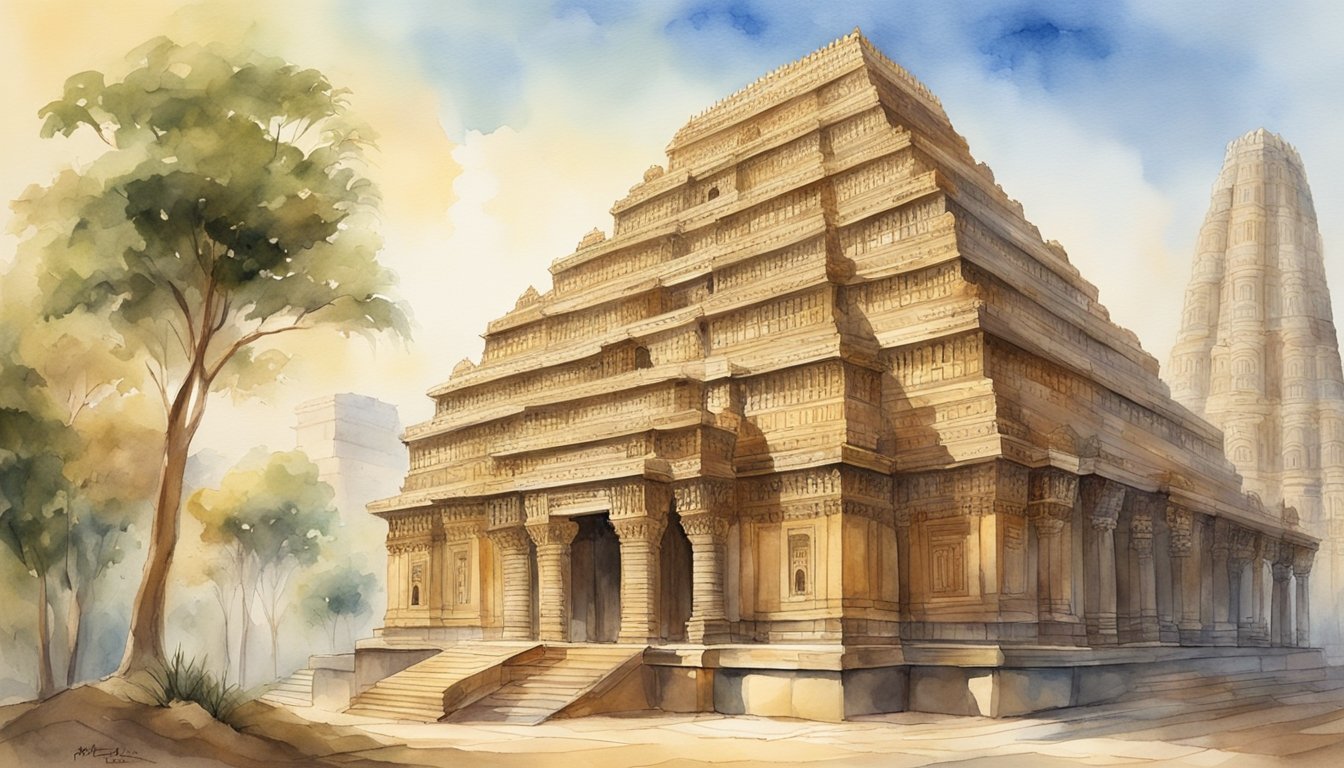Historical Context of Solomon’s Temple

Biblical Account and King Solomon’s Reign
Solomon’s Temple, also known as the First Temple, was built in Jerusalem during the reign of King Solomon, son of King David. According to the Hebrew Bible, the construction of the temple started in 967 BCE and was completed in 957 BCE. The temple was built using wood from Lebanon and gold from Ophir mines, which were transported by ship via the Red Sea. The main text describing the temple’s construction can be found in the Bible’s 1 Kings 6-7.
The inside ceiling of the temple was approximately 180 feet long, 90 feet wide, and 50 feet high. The highest point was 120 cubits tall (around 207 feet). The temple’s most sacred chamber, the Holy of Holies, housed the Ark of the Covenant and was adorned with two cherubim sculptures made of gold.
Temple Mount: A Symbolic Landmark
The Temple Mount is a significant landmark in Jerusalem, both historically and symbolically. It is located on Mount Moriah, where the binding of Isaac by Abraham took place, as described in the Bible. The Temple Mount is considered a holy place in Judaism, Christianity, and Islam, and over time, other important religious structures like the Dome of the Rock and Al-Aqsa Mosque were built on this site.
In the ancient Near East, the temple was an important site for religious activities, such as sacrifices and worship, and it was served by priests and scribes from the kingdom of Judea.
Cultural and Religious Significance in Judaism
Solomon’s Temple held great cultural and religious significance in Judaism. It symbolized the presence of God among the people of Israel and served as a central place of worship, where prayers and sacrifices were offered. While other sanctuaries existed in the region during the time of Solomon’s Temple, King Josiah (c. 640-609 BCE) abolished them and established the Temple of Jerusalem as the only place of sacrifice in the Kingdom of Judah.
Unfortunately, the First Temple was destroyed by the Babylonians in 586 BCE, but its memory has continued to hold great importance in Jewish tradition and history. Knowledge of Solomon’s Temple’s history, design, and location can help deepen the understanding and reverence for one of the world’s most sacred sites.
Archaeological Insights and Modern Reflections
Archaeological Excavations and Discoveries
In recent years, archaeological excavations have brought to light fascinating insights about Solomon’s Temple, once the crown jewel of Jerusalem. Israeli archaeologists have presented the first tiny artifacts discovered on the Temple Mount, which is currently home to the Dome of the Rock and Al-Aqsa Mosque 1. The Temple Mount Sifting Project, a joint effort between the Israel Antiquities Authority and the Biblical Archaeology Society, has examined materials extracted from the mount and found numerous items dating back to the time of the First Temple.
Through the efforts of various archaeological organizations and researchers including historians, biblical scholars, and archaeologists, animal bones and pottery shards have been discovered 2. Also, inscriptions in Aramaic writing add a layer of historical complexity. Digs undertaken in Levant, the surrounding area of the Holy Land, have revealed architectural details like doorframes, structures similar to Jewish Temples, and artifacts with Assyrian and Roman influence. These findings provide valuable insights into the daily lives, religious practices, and interactions of ancient civilizations in the region. Additionally, the discovery of ancient texts, including biblical manuscripts, contributes to the ongoing discussion of Dead Sea Scrolls meaning and their historical significance. Such excavations help bridge the gap between historical accounts and material evidence, offering a richer understanding of the past.
In addition to these findings, a stela – or an inscribed stone monument – found in Tel Dan in northern Israel bears witness to the historical impact that Solomon’s Temple had in the region. The stela’s Aramaic writing and motifs, such as lions and sphinxes, convey the cultural background during that time 3.
Contemporary Significance and Interpretations
Solomon’s Temple serves as a focal point in the religious and historical narratives of the Old Testament, the Hebrew Bible, and later, in the context of the Kingdom of Judah. With a construction period of seven years, according to 2 Chronicles, the Temple was the center of worship for the Jewish people in the land of Israel. Despite its ultimate destruction by Nebuchadnezzar II during the Siege of Jerusalem, its memory persists.
Today, Solomon’s Temple is remembered for various reasons. The tabernacle, or portable sanctuary, located on Mount Moriah 4 in Jerusalem, was replaced with the Temple as a dedicated holy place. The biblical story of King Solomon’s Temple serves as a foundation for a long and intricate tradition about the sanctuary, which was rebuilt and later expanded by King Herod 5.
Moreover, the Temple served as a cultural and spiritual symbol in the past, and modern authorities still feel its echoes over a millennia later. The site has been at the center of various religious schisms, such as Yom Kippur, and political events, including the Crusades. The intertwining of religious and historical narratives regarding Solomon’s Temple adds depth to the inquiry into its archaeological remains, and its connections with the present-day Holy Land continue to stir thoughts on its significance.

